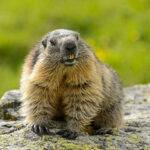Marmot Day takes place on February 2 every year. It is an Alaskan holiday established to celebrate marmots and Alaskan culture. Although local festivals have been part of frontier life for decades, Marmot Day became an official holiday in 2009, when the 26th Alaska State Legislature officially passed Senate Bill 58.
History of Marmot Day
Marmots are large rodents with characteristically short but robust legs, enlarged claws well adapted to digging, stout bodies, and large heads and incisors to quickly process a variety of vegetation. These herbivores are active during the summer when often found in groups, but are seen during the winter when they hibernate underground.
Marmots typically live in burrows and hibernate there through the winter. Most marmots are highly social and use loud whistles to communicate with one another, especially when alarmed. They mainly eat greens and many types of grasses, berries, lichens, mosses, roots, and flowers.
Marmot Day is a celebration of marmots, established on April 18, 2009, to celebrate the interesting creature. It is a popular North American tradition that derives from a Pennsylvania Dutch superstition. It has become a popular observance throughout the United States and Canada, and even in some places abroad.
A luncheon is traditional as part of the celebration, marmot jokes and ginger snaps are shared, among other festivities typical of party celebrations. In recent years, the celebration has been held at the Covenant Eyes global headquarters in Shiawassee County. At 12:45 p.m., a marmot is positioned outside its hole, and if it goes into its hole, legend has it summer is over; if it does not go into its hole, it is believed there will be one more month of summer.
Since its establishment over a decade ago, marmot day has become a well-loved Alaskan tradition. It celebrates Alaskan wildlife and helps preserve Alaska’s folk traditions that have declined over the years.
Marmot Day timeline
An anatomically accurate image of a marmot is printed and distributed by Jacopo Ligozi, who is noted for his images of flora and fauna.
Several Himalayan marmot specimens are described and proposed as subspecies.
The Tarbagan marmot is classified as endangered by the International Union for Conservation of Nature (I.U.C.N.).
A photograph of a Himalayan marmot under attack by a Tibetan fox, taken by Yongqing Bao, wins the overall prize in the Wildlife Photographer of the Year category.
Marmot Day FAQs
What can I feed a marmot?
Marmots like to feed on legumes. The forage crop, alfalfa, is a good thing to feed them with, whether fresh or dried. They also love dandelions and cow parsnip, and probably will not need water as long as they’re getting fresh vegetables.
Are marmots and groundhogs the same?
The two animals are not exactly the same. Groundhogs are a type of marmot, and marmots are closely related to squirrels. Yellow-bellied marmots are native to the mountainous region of the western U.S., while groundhogs usually live east of the Rocky Mountains. Also, marmots are social, while groundhogs are solitary and protective of their territory.
Do marmots make good pets?
Naturally, they don’t. Because marmots are wild animals, they do not make the best companions, and it is illegal to own one as a pet in the United States.
Marmot Day Activities
Donate to programs to protect marmots
Some organizations have risen to combat the rise in the number of endangered marmot species. Make your contribution to this cause by donating whatever amount you can.
Buy stuffed marmot toys
Marmots are cute animals, and their stuffed versions are even cuter. Spend some money purchasing them for kids, friends, and even yourself.
Watch marmot videos
Marmots are really interesting creatures that perform funny acts at times. Some of these acts have been recorded and uploaded online by people. Spend some time today watching those videos.
5 Facts About Marmots That Will Fascinate You
They are relatively heavy
Marmots are the heaviest members of the squirrel family, with body mass at times exceeding 24 pounds in the larger species.
They hibernate for most of the year
Marmots are only active for four months and hibernate the rest of the year.
They vary in color
Species in more open habitats are more likely to have paler color, while those sometimes found in well-forested regions tend to be darker.
They can dig really deep
Their burrow can stretch up to 65 feet long and extend five feet deep.
They can experience albinism
Albinism occurs in the grey marmot species.
Why We Love Marmot Day
Marmots are really interesting creatures
Marmots are cute and curious mammals that can be fun to watch do their things. They help showcase nature’s beauty and awesomeness.
It helps preserve Alaskan culture
Marmots are an inherent part of Alaskan culture. This day helps preserve the sanctity of that culture.
It raises awareness
The day helps draw attention to the declining marmot numbers and attempts to put an end to the man-made factors causing this reduction. This ultimately helps achieve a balanced ecosystem in the long run.
Marmot Day dates
| Year | Date | Day |
|---|---|---|
| 2025 | February 2 | Sunday |
| 2026 | February 2 | Monday |
| 2027 | February 2 | Tuesday |
| 2028 | February 2 | Wednesday |
| 2029 | February 2 | Friday |




































